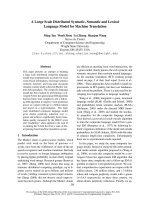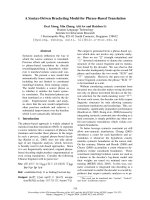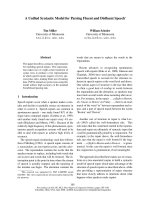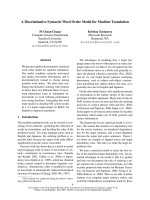Báo cáo khoa học: "A Translation Aid System with a Stratified Lookup Interface" doc
Bạn đang xem bản rút gọn của tài liệu. Xem và tải ngay bản đầy đủ của tài liệu tại đây (328.96 KB, 4 trang )
Proceedings of the ACL 2007 Demo and Poster Sessions, pages 5–8,
Prague, June 2007.
c
2007 Association for Computational Linguistics
A Translation Aid System with a Stratified Lookup Interface
Takeshi Abekawa and Kyo Kageura
Library and Information Science Course
Graduate School of Education,
University of Tokyo, Japan
{abekawa,kyo}@p.u-tokyo.ac.jp
Abstract
We are currently developing a translation
aid system specially designed for English-
to-Japanese volunteer translators working
mainly online. In this paper we introduce
the stratified reference lookup interface that
has been incorporated into the source text
area of the system, which distinguishes three
user awareness levels depending on the type
and nature of the reference unit. The dif-
ferent awareness levels are assigned to ref-
erence units from a variety of reference
sources, according to the criteria of “com-
position”, “difficulty”, “speciality” and “re-
source type”.
1 Introduction
A number of translation aid systems have been de-
veloped so far (Bowker, 2002; Gow, 2003). Some
systems such as TRADOS have proved useful for
some translators and translation companies
1
. How-
ever, volunteer (and in some case freelance) trans-
lators do not tend to use these systems (Fulford and
Zafra, 2004; Fulford, 2001; Kageura et al., 2006),
for a variety of reasons: most of them are too expen-
sive for volunteer translators
2
; the available func-
tions do not match the translators’ needs and work
style; volunteer translators are under no pressure
from clients to use the system, etc. This does not
mean, however, that volunteer translators are satis-
fied with their working environment.
Against this backdrop, we are developing a trans-
lation aid system specially designed for English-to-
Japanese volunteer translators working mainly on-
line. This paper introduces the stratified reference
1
/>2
Omega-T, />lookup/notification interface that has been incorpo-
rated into the source text area of the system, which
distinguishes three user awareness levels depending
on the type and nature of the reference unit. We
show how awareness scores are given to the refer-
ence units and how these scores are reflected in the
way the reference units are displayed.
2 Background
2.1 Characteristics of target translators
Volunteer translators involved in translating English
online documents into Japanese have a variety of
backgrounds. Some are professional translators,
some are interested in the topic, some translate as a
part of their NGO activities, etc
3
. They nevertheless
share a few basic characteristics: (i) they are native
speakers of Japanese (the target language: TL); (ii)
most of them do not have a native-level command in
English (the source language: SL); (iii) they do not
use a translation aid system or MT; (iv) they want to
reduce the burden involved in the process of transla-
tion; (v) they spend a huge amount of time looking
up reference sources; (vi) the smallest basic unit of
translation is the paragraph and “at a glance” read-
ability of the SL text is very important. A translation
aid system for these translators should provide en-
hanced and easy-to-use reference lookup functions
with quality reference sources. An important point
expressed by some translators is that they do not
want a system that makes decisions on their behalf;
they want the system to help them make decisions
by making it easier for them to access references.
Decision-making by translations in fact constitutes
an essential part of the translation process (Munday,
2001; Venuti, 2004).
3
We carried outa questionnaire survey of 15 volunteer trans-
lators and interviewed 5 translators.
5
Some of these characteristics contrast with those
of professional translators, for instance, in Canada
or in the EU. They have native command in both
the source and target languages; they went through
university-level training in translation; many of them
have a speciality domain; they work on the principle
that “time is money”
4
. For this type of translator,
facilitating target text input can be important, as is
shown in the TransType system (Foster et al., 2002;
Macklovitch, 2006).
2.2 Reference units and lookup patterns
The major types of reference unit can be sum-
marised as follows (Kageura et al., 2006).
Ordinary words: Translators are mostly satisfied
with the information provided in existing dictionar-
ies. Looking up these references is not a huge bur-
den, though reducing it would be preferable.
Idioms and phrases: Translators are mostly sat-
isfied with the information provided in dictionaries.
However, the lookup process is onerous and many
translators worry about failing to recognise idioms
in SL texts (as they can often be interpreted liter-
ally), which may lead to mistranslations.
Technical terms: Translators are not satisfied
with the available reference resources
5
; they tend
to search the Internet directly. Translators tend to be
concerned with failing to recognise technical terms.
Proper names: Translators are not satisfied with
the available reference resources. They worry more
about misidentifying the referent. For the identifica-
tion of the referent, they rely on the Internet.
3 The translation aid system: QRedit
3.1 System overview
The system we are developing, QRedit, has been de-
signed with the following policies: making it less
onerous for translators to do what they are currently
doing; providing information efficiently to facilitate
decision-making by translators; providing functions
in a manner that matches translators’ behaviour.
QRedit operates on the client server model. It is
implemented by Java and run on Tomcat. Users ac-
4
Personal communication with Professor Elliott
Macklovitch at the University of Montreal, Canada.
5
With the advent of Wikipedia, this problem is gradually
becoming less important.
cess the system through Web browsers. The inte-
grated editor interface is divided into two main ar-
eas: the SL text area and the TL editing area. These
scroll synchronically. To enable translators to main-
tain their work rhythm, the keyboard cursor is al-
ways bound to the TL editing area (Abekawa and
Kageura, 2007).
3.2 Reference lookup functions
Reference lookup functions are activated when an
SL text is loaded. Relevant information (translation
candidates and related information) is displayed in
response to the user’s mouse action. In addition to
simple dictionary lookup, the system also provides
flexible multi-word unit lookup mechanisms. For
instance, it can automatically look up the dictionary
entry “with one’s tongue in one’s cheek” for the ex-
pression “He said that with his big fat tongue in his
big fat cheek” or “head screwed on right” for “head
screwed on wrong” (Kanehira et al., 2006).
The reference information can be displayed in two
ways: a simplified display in a small popup window
that shows only the translation candidates, and a full
display in a large window that shows the full refer-
ence information. The former is for quick reference
and the latter for in-depth examination.
Currently, Sanseido’s Grand Concise English-
Japanese Dictionary, Eijiro
6
, List of technical terms
in 23 domains, and Wikipedia are provided as refer-
ence sources.
4 Stratified reference lookup interface
In relation to reference lookup functions, the follow-
ing points are of utmost importance:
1. In the process of translation, translators often
check multiple reference resources and exam-
ine several meanings in SL and expressions in
TL. We define the provision of “good informa-
tion” for the translator by the system as infor-
mation that the translator can use to make his
or her own decisions.
2. The system should show the range of avail-
able information in a manner that corresponds
to the translator’s reference lookup needs and
behaviour.
6
/>6
The reference lookup functions can be divided
into two kinds: (i) those that notify the user of the
existence of the reference unit, and (ii) those that
provide reference information. Even if a linguistic
unit is registered in reference sources, if the transla-
tor is unaware of its existence, (s)he will not look
up the reference, which may result in mistransla-
tion. It is therefore preferable for the system to no-
tify the user of the possible reference units. On the
other hand, the richer the reference sources become,
the greater the number of candidates for notification,
which would reduce the readability of SL texts dra-
matically. It was necessary to resolve this conflict
by striking an appropriate balance between the no-
tification function and user needs in both reference
lookup and the readability of the SL text.
4.1 Awareness levels
To resolve this conflict, we introduced three transla-
tor “awareness levels”:
• Awareness level -2: Linguistic units that the
translator may not notice, which will lead to
mistranslation. The system always actively no-
tifies translators of the existence of this type of
unit, by underlining it. Idioms and complex
technical terms are natural candidates for this
awareness level.
• Awareness level -1: Linguistic units that trans-
lators may be vaguely aware of or may suspect
exist and would like to check. To enable the
user to check their existence easily, the rele-
vant units are displayed in bold when the user
moves the cursor over the relevant unit or its
constituent parts with the mouse. Compounds,
easy idioms and fixed expressions are candi-
dates for this level.
• Awareness level 0: Linguistic units that the
user can always identify. Single words and easy
compounds are candidates for this level.
In all these cases, the system displays reference in-
formation when the user clicks on the relevant unit
with the mouse.
4.2 Assignment of awareness levels
The awareness levels defined above are assigned to
the reference units on the basis of the following four
characteristics:
C(unit): The compositional nature of the unit.
Single words can always be identified in texts, so
the score 0 is assigned to them. The score -1 is as-
signed to compound units. The score -2 is assigned
to idioms and compound units with gaps.
D(unit): The difficulty of the linguistic unit for a
standard volunteer translator. For units in the list of
elementary expressions
7
, the score 1 is given. The
score 0 is assigned to words, phrases and idioms
listed in general dictionaries. The score -1 is as-
signed to units registered only in technical term lists.
S(unit): The degree of domain dependency of the
unit. The score -1 is assigned to units that belong to
the domain which is specified by the user. The score
0 is assigned to all the other units. The domain infor-
mation is extracted from the domain tags in ordinary
dictionaries and technical term lists. For Wikipedia
entries the category information is used.
R(unit): The type of reference source to which the
unit belongs. We distinguish between dictionaries
and encyclopaedia, corresponding to the user’s in-
formation search behaviour. The score -1 is assigned
to units which are registered in the encyclopaedia
(currently Wikipedia
8
), because the fact that fac-
tual information is registered in existing reference
sources implies that there is additional information
relating to these units which the translator might
benefit from knowing. The score 0 is assigned to
units in dictionaries and technical term lists.
The overall score A(unit) for the awareness level
of a linguistic unit is calculated by:
A(unit) = C(unit)+D(unit)+S(unit)+R(unit).
Table 1 shows the summary of awareness levels
and the scores of each characteristic. For instance, in
an the SL sentence “The airplane took right off.”, the
C(take off) = −2, D(take off) = 1, S(take off) =
0 and R(take off) = 0; hence A(take off) = −1.
A score lower than -2 is normalised to -2, and a
score higher than 0 is normalised to 0, because we
assume three awareness levels are convenient for re-
alising the corresponding notification interface and
7
This list consists of 1,654 idioms and phrases taken from
multiple sources for junior high school and high school level
English reference sources published in Japan.
8
As the English Wikipedia has entries for a majority of or-
dinary words, we only assign the score -1 to proper names.
7
A(unit) : awareness level <= -2 -1 >= 0
Mode of alert always emphasis by mouse-over none
Score -2 -1 0 1
C(unit) : composition compound unit with gap compound unit single word
D(unit) : difficulty technical term general term elementary term
S(unit) : speciality specified domain general domain
R(unit) : resource type encyclopaedia dictionary
Table 1: Awareness levels and the scores of each characteristic
are optimal from the point of view of the user’s
search behaviour. We are currently examining user
customisation functions.
5 Conclusion
In this paper, we introduced a stratified reference
lookup interface within a translation aid environ-
ment specially designed for English-to-Japanese on-
line volunteer translators. We described the incorpo-
ration into the system of different “awareness levels”
for linguistic units registered in multiple reference
sources in order to optimise the reference lookup in-
terface. The incorporation of these levels stemmed
from the basic understanding we arrived at after con-
sulting with actual translators that functions should
fit translators’ actual behaviour. Although the effec-
tiveness of this interface is yet to be fully examined
in real-world situations, the basic concept should be
useful as the idea of awareness level comes from
feedback by monitors who used the first version of
the system.
Although in this paper we focused on the use
of established reference resources, we are currently
developing (i) a mechanism for recycling relevant
existing documents, (ii) dynamic lookup of proper
name transliteration on the Internet, and (iii) dy-
namic detection of translation candidates for com-
plex technical terms. How to fully integrate these
functions into the system is our next challenge.
References
Takeshi Abekawa and Kyo Kageura. 2007. Qredit:
An integrated editor system to support online volun-
teer translators. In Proceedings of Digital Humanities
2007 Poster/Demos.
Lynne Bowker. 2002. Computer-aided Translation Tech-
nology: A Practical Introduction. Ottawa: University
of Ottawa Press.
George Foster, Philippe Langlais, and Guy Lapalme.
2002. User-friendly text prediction for translators.
In Proceedings of the 2002 Conference on Empirical
Methods in Natural Language Processing, pages 148–
155.
Heather Fulford and Joaqu
´
ın Granell Zafra. 2004. The
uptake of online tools and web-based language re-
sources by freelance translators. In Proceedings of
the Second International Workshop on Language Re-
sources for Translation Work, Research and Training,
pages 37–44.
Heather Fulford. 2001. Translation tools: An ex-
ploratory study of their adoption by UK freelance
translators. Machine Translation, 16(3):219–232.
Francie Gow. 2003. Metrics for Evaluating Translation
Memory Software. PhD thesis, Ottawa: University of
Ottawa.
Kyo Kageura, Satoshi Sato, Koichi Takeuchi, Takehito
Utsuro, Keita Tsuji, and Teruo Koyama. 2006. Im-
proving the usability of language reference tools for
translators. In Proceedings of the 10th of Annual
Meeting of Japanese Natural Language Processing,
pages 707–710.
Kou Kanehira, Kazuki Hirao, Koichi Takeuchi, and Kyo
Kageura. 2006. Development of a flexible idiom
lookup system with variation rules. In Proceedings
of the 10th Annual Meeting of Japanese Natural Lan-
guage Processing, pages 711–714.
Elliott Macklovitch. 2006. Transtype2: the last word.
In Proceedings of the Fifth International Conference
on Language Resources and Evaluation (LREC2006),
pages 167–172.
Jeremy Munday. 2001. Introducing Translation Studies:
Theories and Applications. London: Routledge.
Lawrence Venuti. 2004. The Translation Studies Reader.
London: Routledge, second edition.
8









